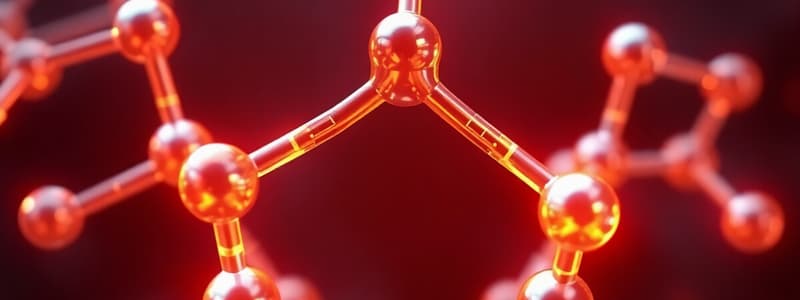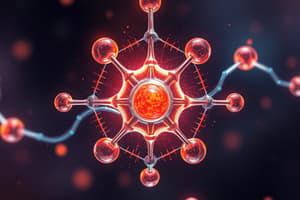Podcast
Questions and Answers
What key feature distinguishes the structure of benzene from that of typical polyenes?
What key feature distinguishes the structure of benzene from that of typical polyenes?
- Benzene has a linear structure.
- Benzene exhibits a high level of reactivity.
- Benzene has alternating single and double bonds.
- Benzene contains delocalized electrons. (correct)
Which statement correctly describes the Kekulé structure of benzene?
Which statement correctly describes the Kekulé structure of benzene?
- It suggests that benzene has fixed single and double bonds. (correct)
- It accounts for the resonance energy of benzene.
- It provides an accurate representation of benzene's electron distribution.
- It presents benzene as a linear molecule.
What type of stability is primarily due to the resonance structures of benzene?
What type of stability is primarily due to the resonance structures of benzene?
- Electronic stability. (correct)
- Molecular stability.
- Kinetic stability.
- Thermodynamic stability.
Which experimental evidence primarily supports the concept of aromaticity in benzene?
Which experimental evidence primarily supports the concept of aromaticity in benzene?
How do resonance structures contribute to the concept of aromatic stability?
How do resonance structures contribute to the concept of aromatic stability?
What significant characteristic of benzene explains its unreactivity compared to other alkenes?
What significant characteristic of benzene explains its unreactivity compared to other alkenes?
Which molecular feature is directly linked to benzene's resonance stability?
Which molecular feature is directly linked to benzene's resonance stability?
What led Michael Faraday to isolate benzene from coal tar distillation?
What led Michael Faraday to isolate benzene from coal tar distillation?
Which of the following is NOT a reason for the historical controversy surrounding the structure of benzene?
Which of the following is NOT a reason for the historical controversy surrounding the structure of benzene?
What was the primary inspiration for August Kekulé's proposal of the benzene structure?
What was the primary inspiration for August Kekulé's proposal of the benzene structure?
What key feature distinguishes the structure of benzene from Kekulé's original representation?
What key feature distinguishes the structure of benzene from Kekulé's original representation?
What does the delocalization of π electrons in benzene contribute to its structure?
What does the delocalization of π electrons in benzene contribute to its structure?
Which of the following is a misconception about benzene based on Kekulé's proposed structure?
Which of the following is a misconception about benzene based on Kekulé's proposed structure?
What evidence supports the conclusion that benzene is not a triene?
What evidence supports the conclusion that benzene is not a triene?
How does electron diffraction contribute to our understanding of benzene's structure?
How does electron diffraction contribute to our understanding of benzene's structure?
In what way are the two Kekulé structures of benzene considered incorrect?
In what way are the two Kekulé structures of benzene considered incorrect?
Which statement best describes the behavior of benzene's π electrons?
Which statement best describes the behavior of benzene's π electrons?
What conclusion can be drawn about the aromaticity of benzene?
What conclusion can be drawn about the aromaticity of benzene?
What characterizes the acetate anion's stability compared to the ethoxide anion?
What characterizes the acetate anion's stability compared to the ethoxide anion?
Which statement about resonance structures is generally accurate?
Which statement about resonance structures is generally accurate?
How does the distribution of negative charge in hydrogen sulfate contribute to its stability?
How does the distribution of negative charge in hydrogen sulfate contribute to its stability?
What is the relationship between resonance structures and the strength of an acid?
What is the relationship between resonance structures and the strength of an acid?
Which molecule has a resonance hybrid represented by more than two contributing structures?
Which molecule has a resonance hybrid represented by more than two contributing structures?
In the context of aromatic stability, what role do delocalized electrons play?
In the context of aromatic stability, what role do delocalized electrons play?
Which of the following statements correctly describes a Kekulé structure?
Which of the following statements correctly describes a Kekulé structure?
What difference between acetic acid and ethanol contributes to their differing acidity?
What difference between acetic acid and ethanol contributes to their differing acidity?
How many resonance structures can typically be drawn for molecules like hydrogen sulfate?
How many resonance structures can typically be drawn for molecules like hydrogen sulfate?
Which of the following best describes why sulfuric acid is considered a very strong acid?
Which of the following best describes why sulfuric acid is considered a very strong acid?
What does the circle used in the representation of benzene signify in terms of electron count?
What does the circle used in the representation of benzene signify in terms of electron count?
Which feature is characteristic of resonance structures?
Which feature is characteristic of resonance structures?
What is the primary limitation of Lewis structures in representing molecules?
What is the primary limitation of Lewis structures in representing molecules?
Why are the C-O bonds in the acetate anion described as being of equal length?
Why are the C-O bonds in the acetate anion described as being of equal length?
In acetonitrile, what can be inferred about the C-N triple bond from its resonance structures?
In acetonitrile, what can be inferred about the C-N triple bond from its resonance structures?
What aspect of aromatic stability is demonstrated through resonance?
What aspect of aromatic stability is demonstrated through resonance?
How are contributing resonance structures typically represented?
How are contributing resonance structures typically represented?
What is a defining characteristic of the Kekulé structure of benzene?
What is a defining characteristic of the Kekulé structure of benzene?
What does the presence of delocalized electrons in aromatic compounds indicate about their chemical behavior?
What does the presence of delocalized electrons in aromatic compounds indicate about their chemical behavior?
Flashcards are hidden until you start studying
Study Notes
Benzene
- Michael Faraday isolated benzene in 1825 from coal tar distillation.
- Benzene has the formula C6H6.
- Benzene's structure was debated for many years.
- Benzene's behavior is different from typical polyenes due to delocalized electrons.
- Kekule proposed a cyclic structure with alternating single and double bonds in 1872.
Kekule Structure of Benzene
- The Kekule structure shows two resonance structures, but these are not the actual structure.
- The true structure of benzene is a resonance hybrid of the two Kekule structures.
- Diffraction methods confirmed that the carbon-carbon bonds in benzene are equivalent.
- The pi electrons in benzene are equally spread over all six carbon atoms.
- Benzene exhibits a planar hexagonal shape with identical carbon-carbon bond lengths of 140 pm.
Drawing the Structure of Benzene
- The Kekule structures are incorrect by themselves.
- Resonance structures are used to represent the true structure of benzene as a hybrid.
- A circle is sometimes used to represent the equivalence of the carbon-carbon bonds, but this representation is not entirely accurate.
Resonance Structures
- Resonance structures are Lewis structures that show the delocalization of electrons.
- More resonance structures for an ion usually indicate higher stability.
- Acetonitrile is highly polarized due to the C-N triple bond.
- Resonance structures can be drawn to describe the polarization of the C-N triple bond in acetonitrile.
- The acetate anion is more stable than the ethoxide anion because the negative charge is distributed across two oxygen atoms.
Summary
- Aromatic hydrocarbons are an important class of organic compounds.
- Benzene's electronic structure and its unique properties are crucial to understand its behavior.
- Resonance structures provide a better representation of electron distribution in molecules.
- Resonance structures play a role in determining the stability of molecules and ions.
Studying That Suits You
Use AI to generate personalized quizzes and flashcards to suit your learning preferences.




